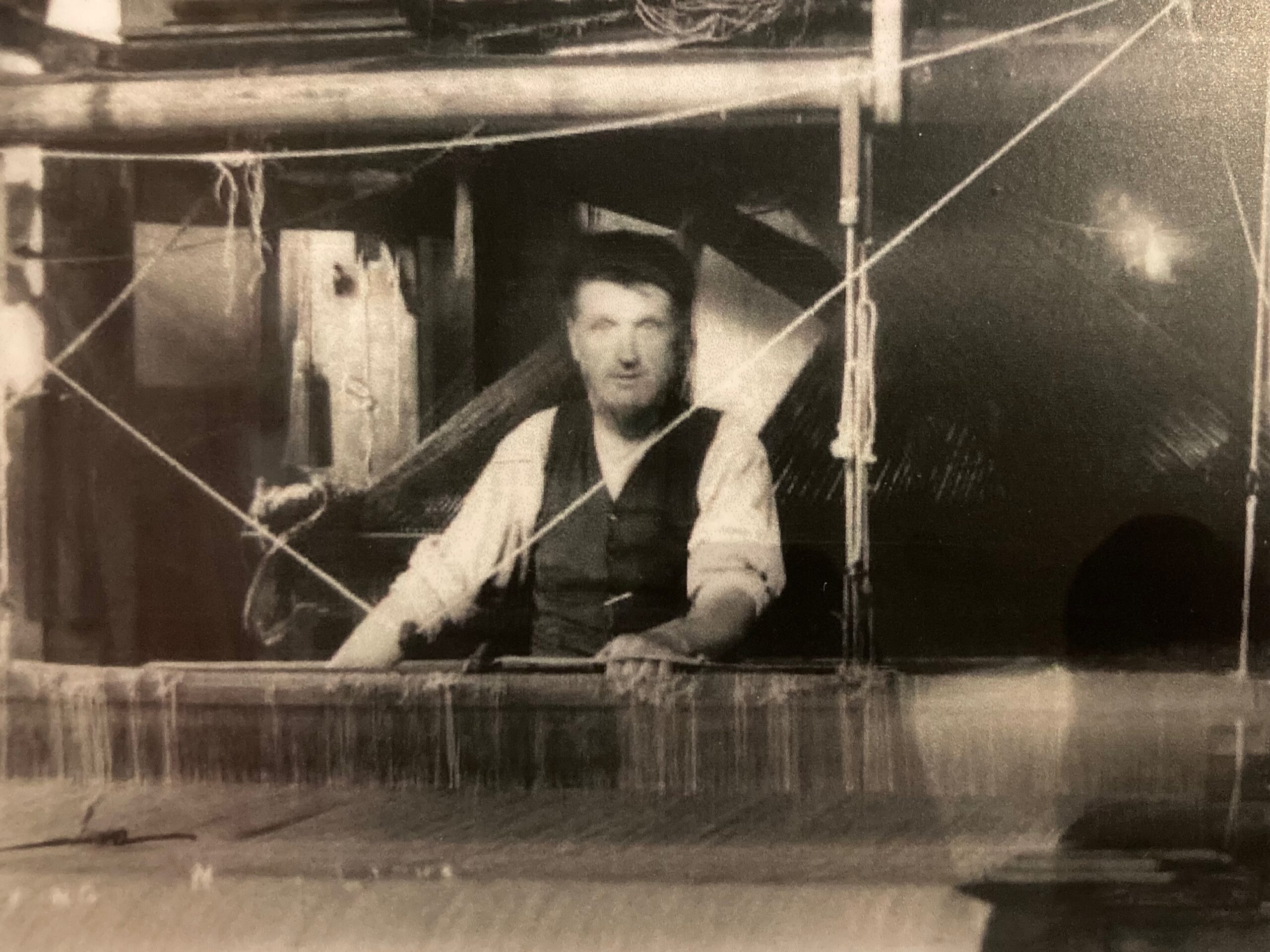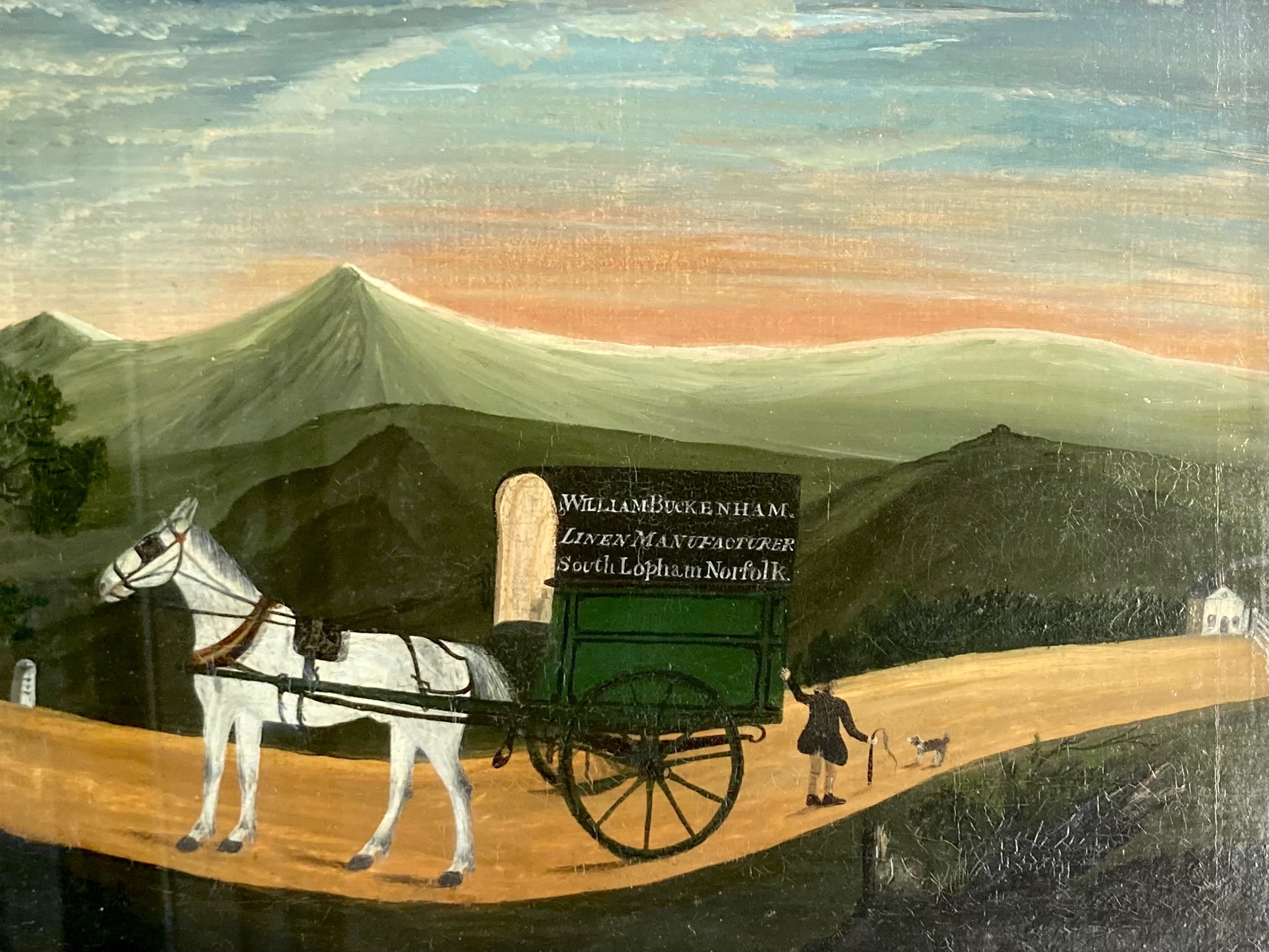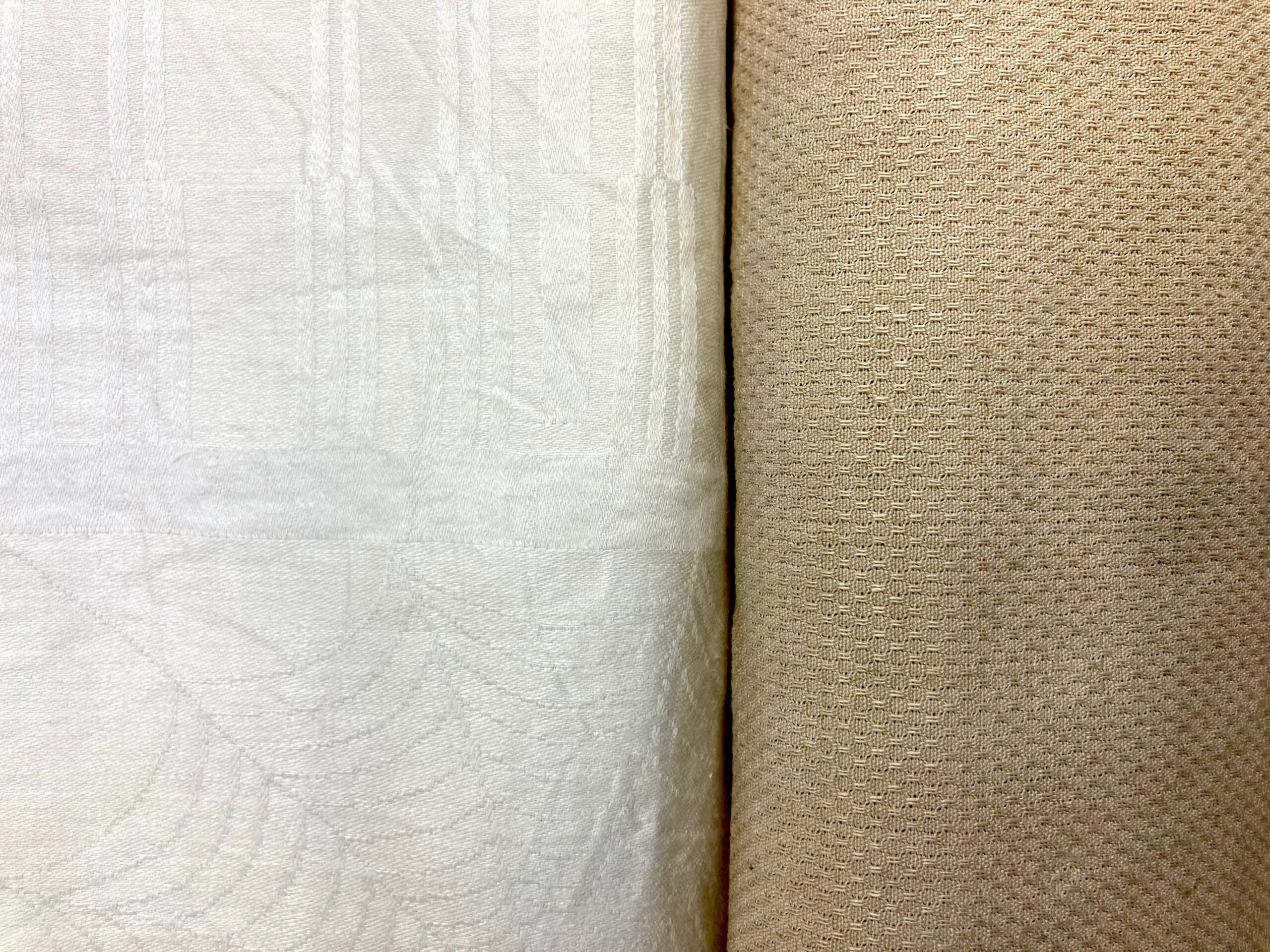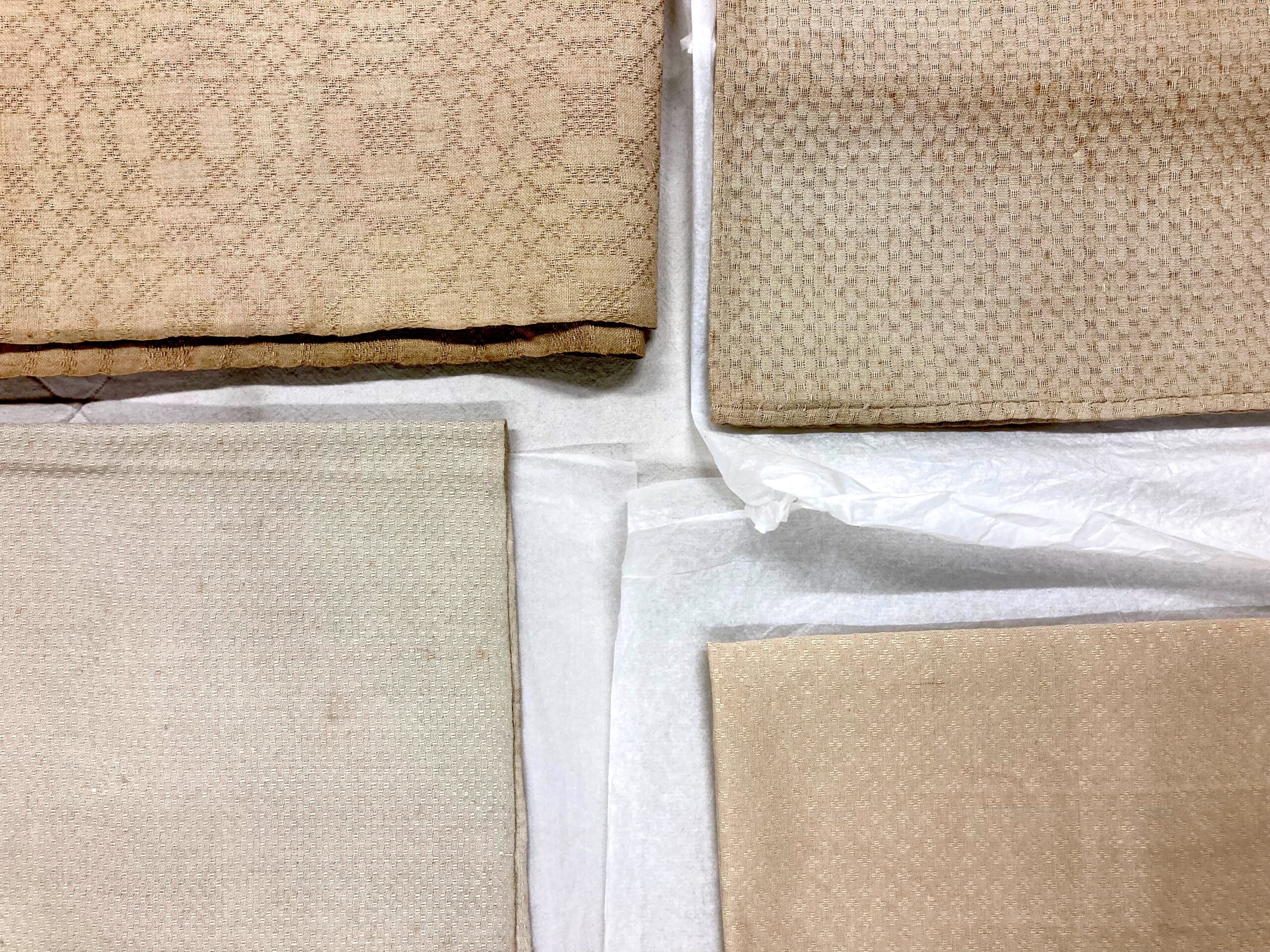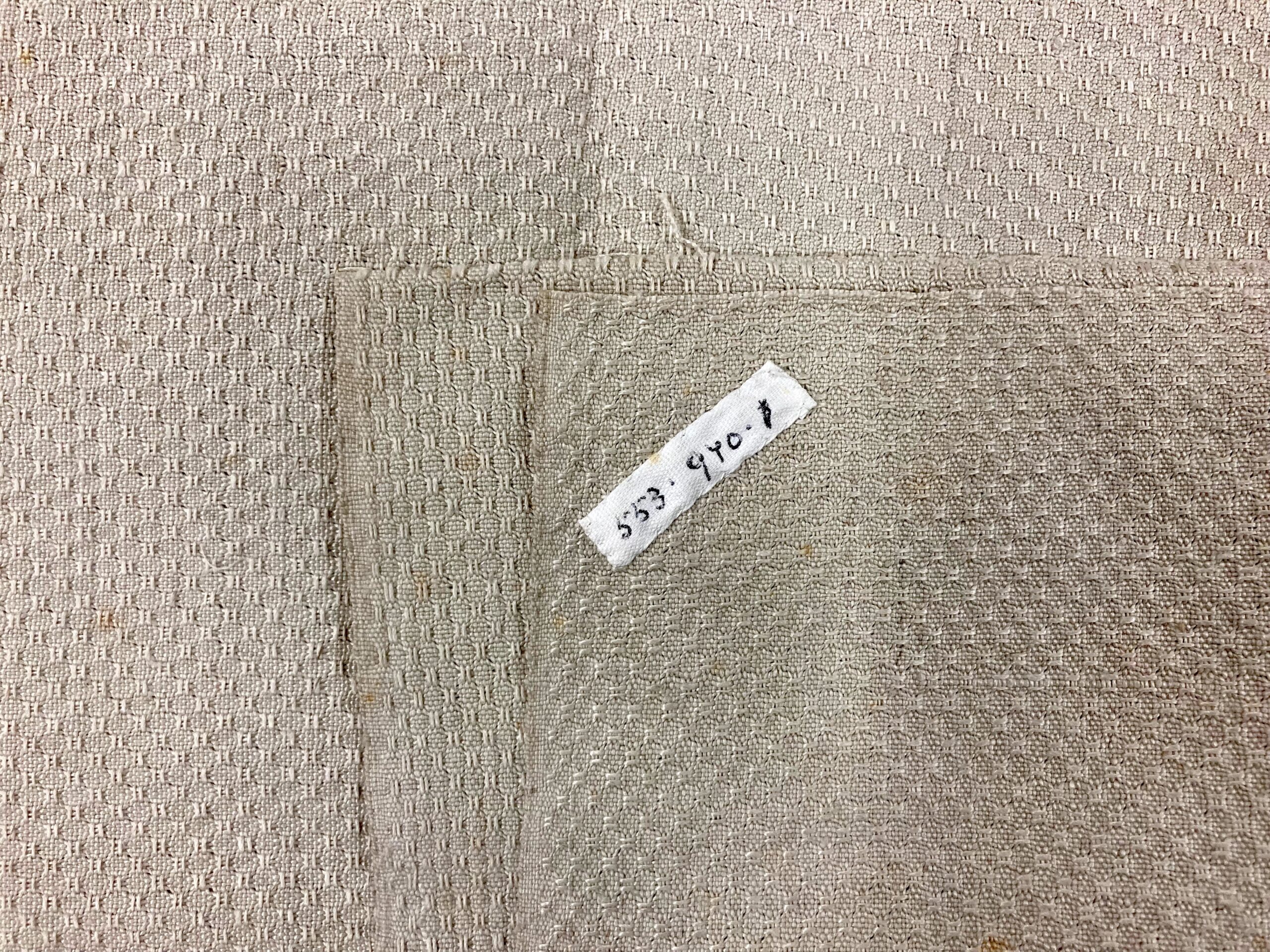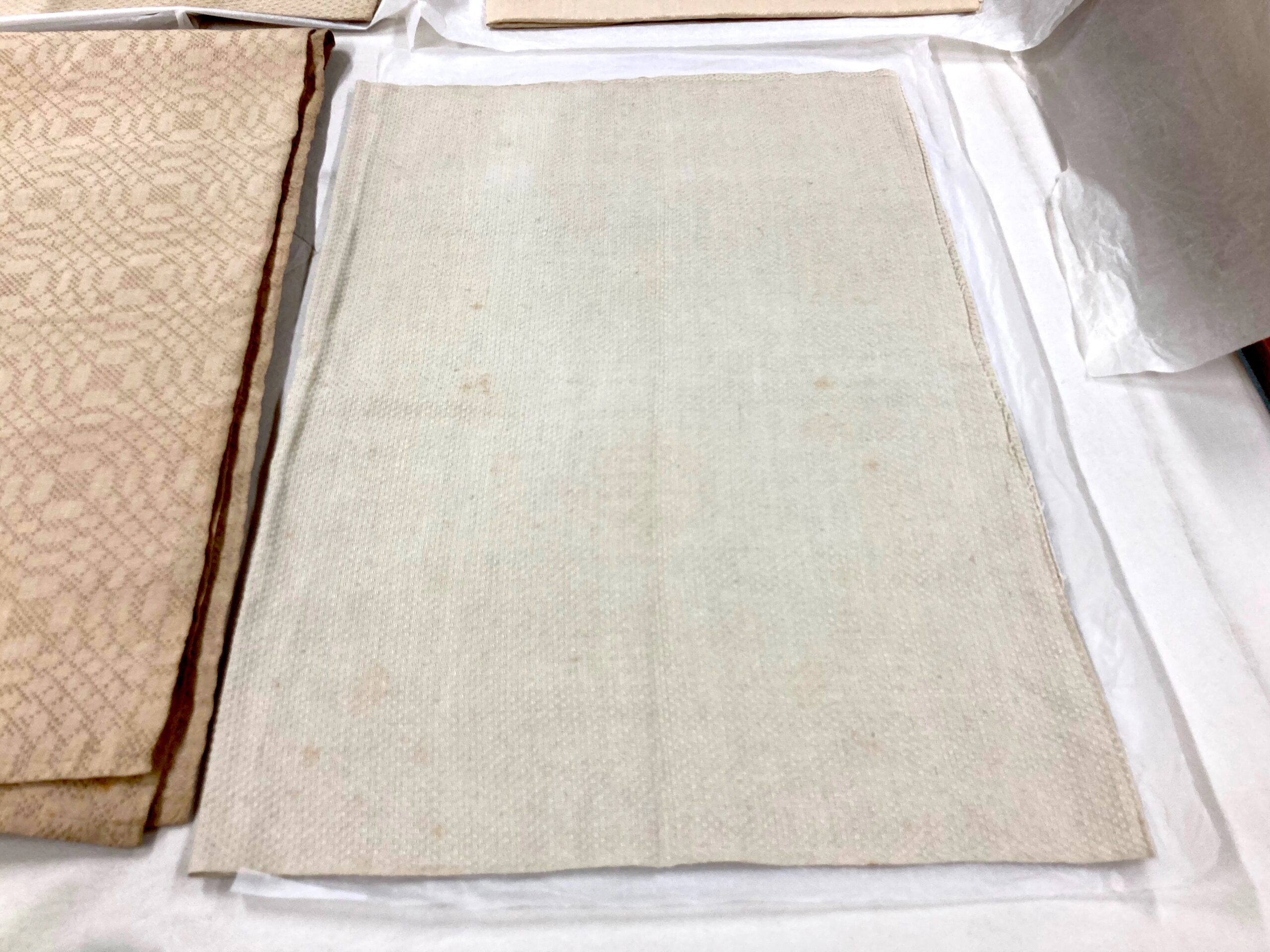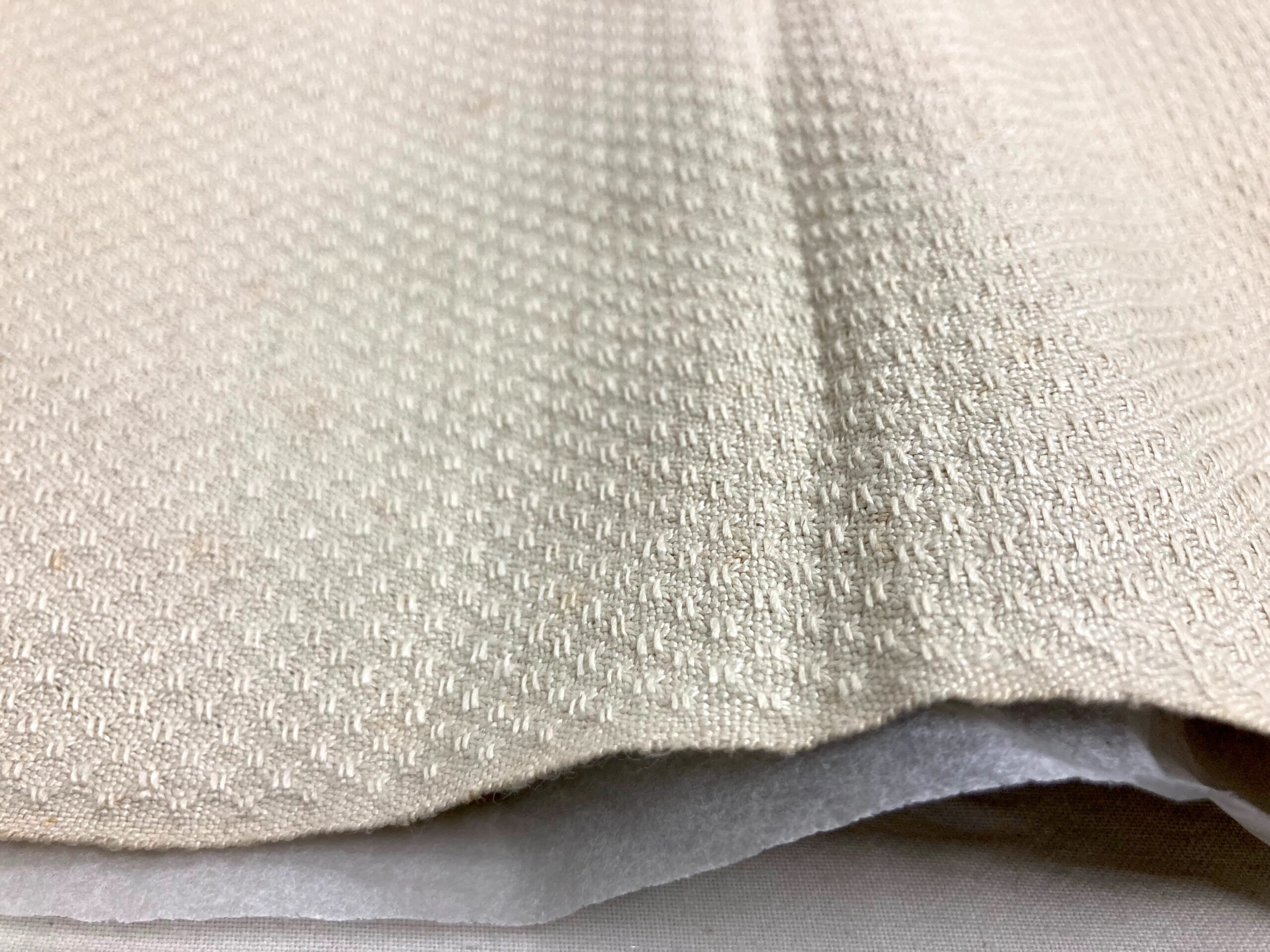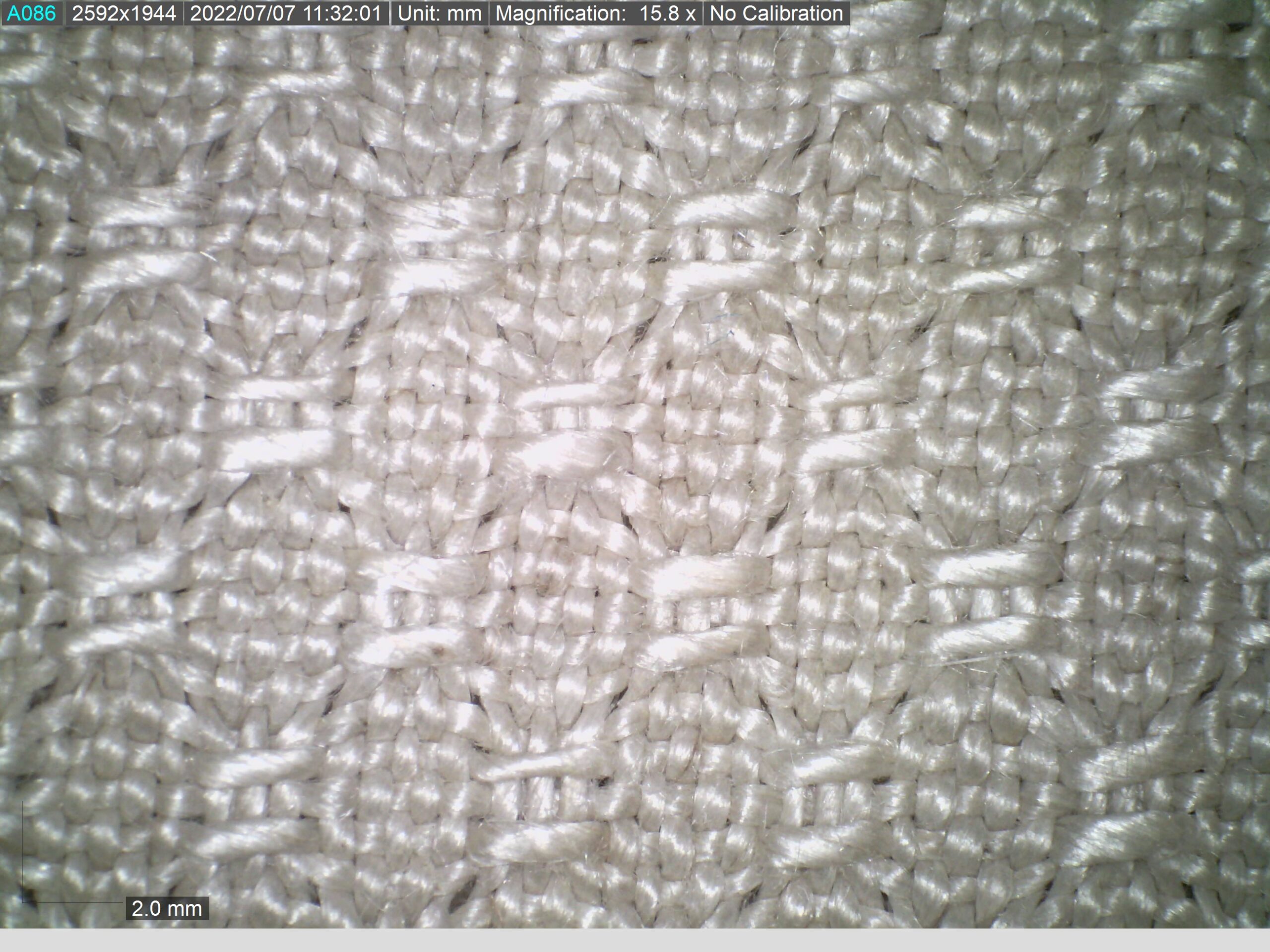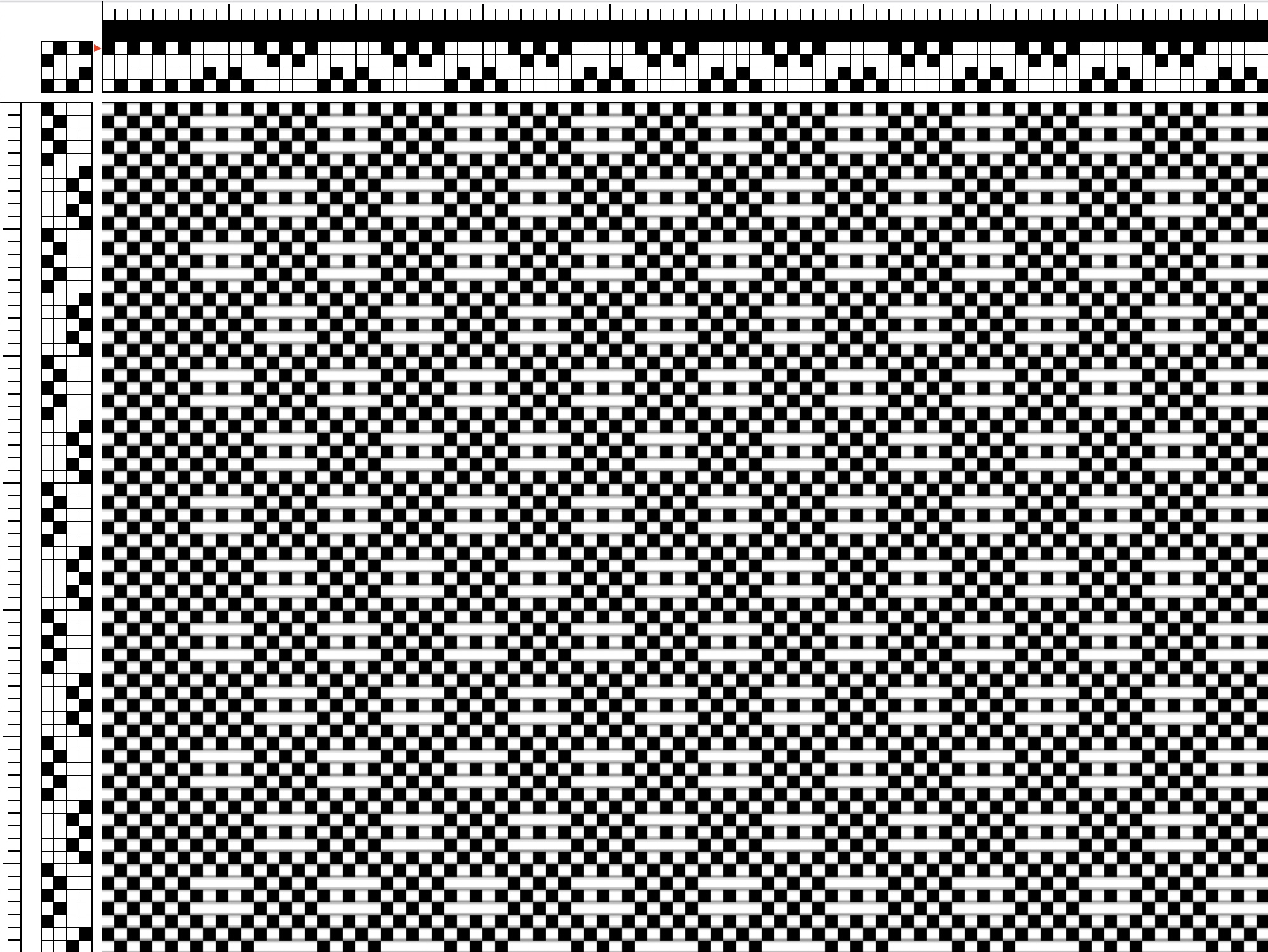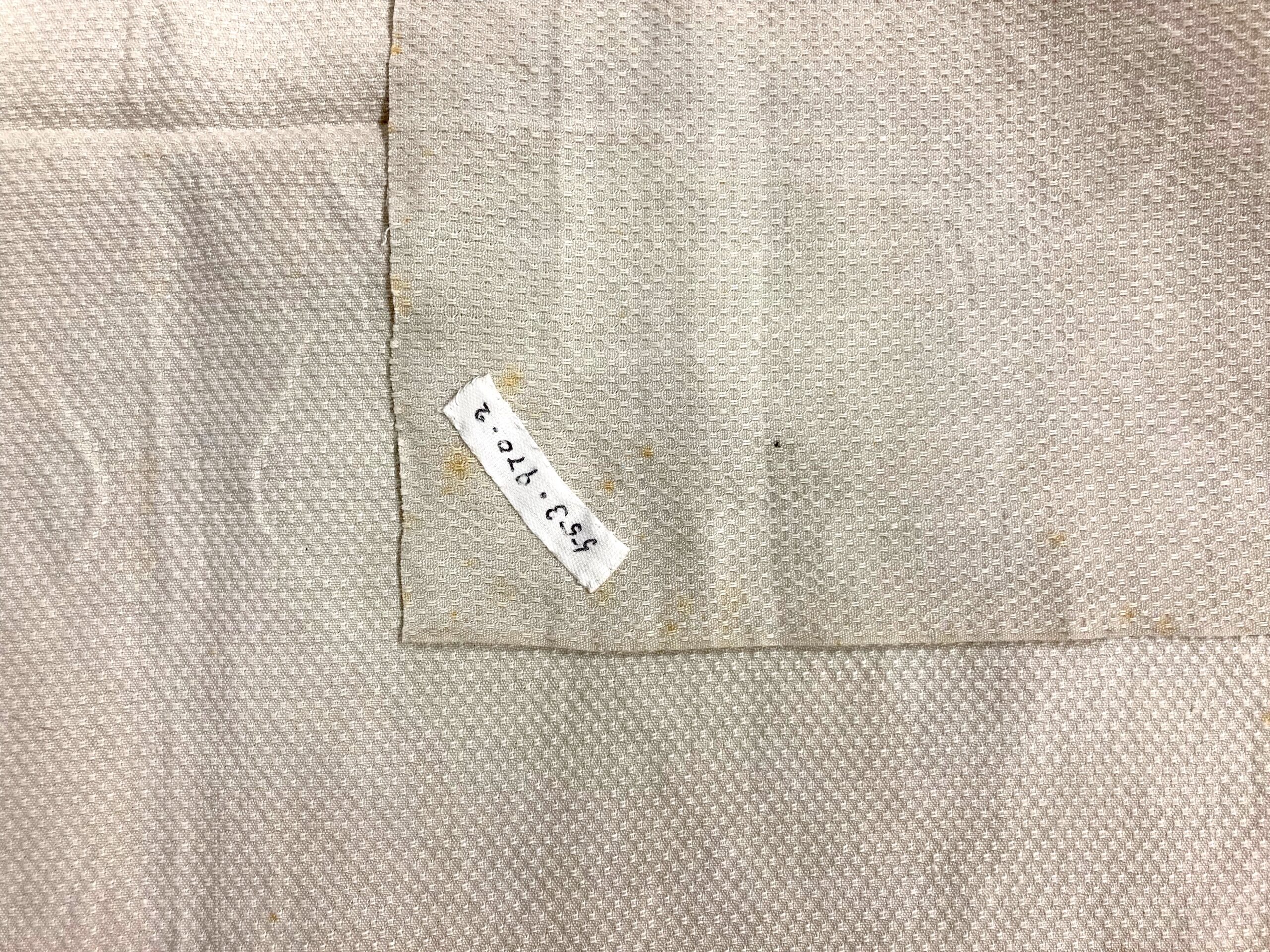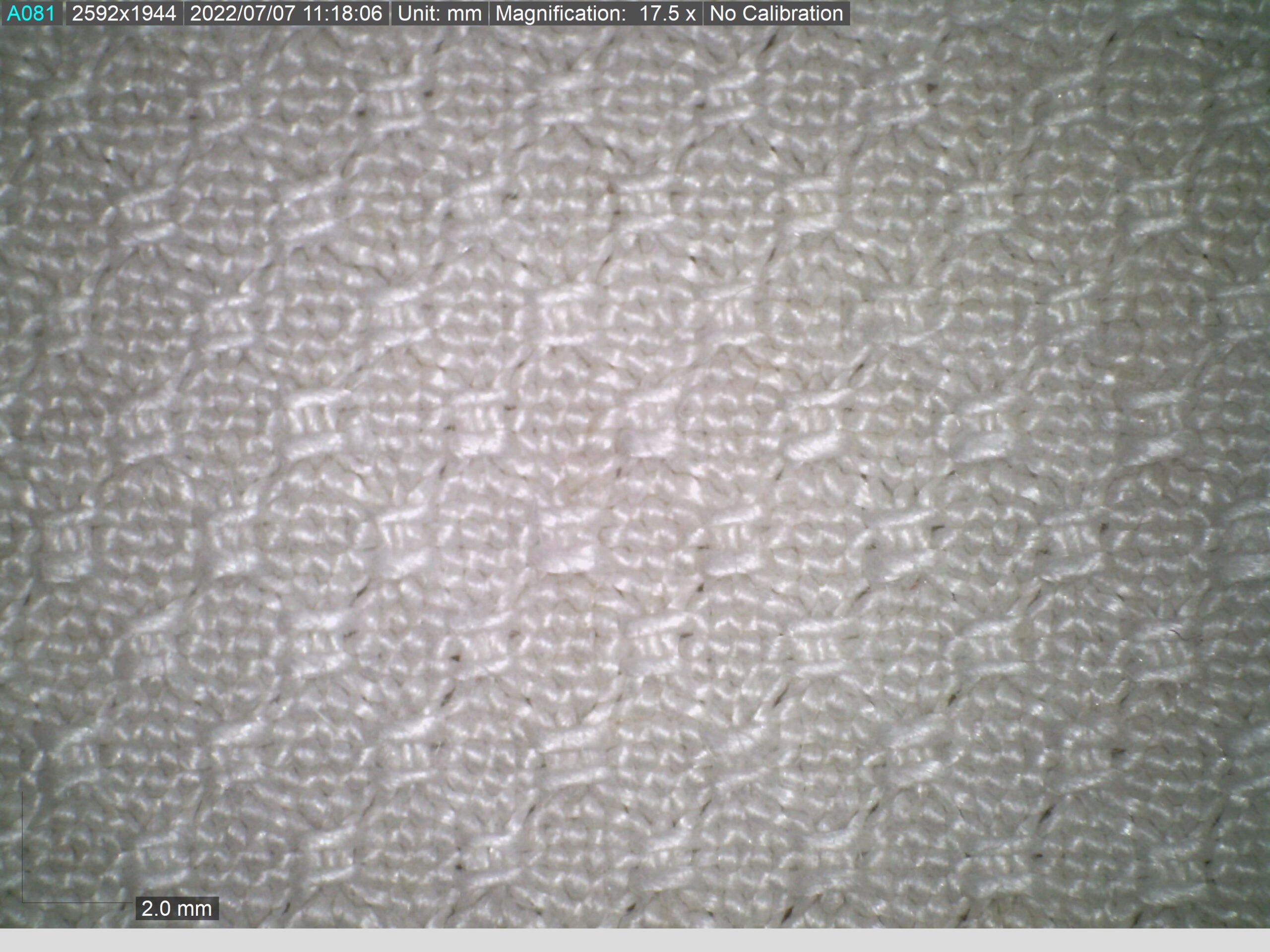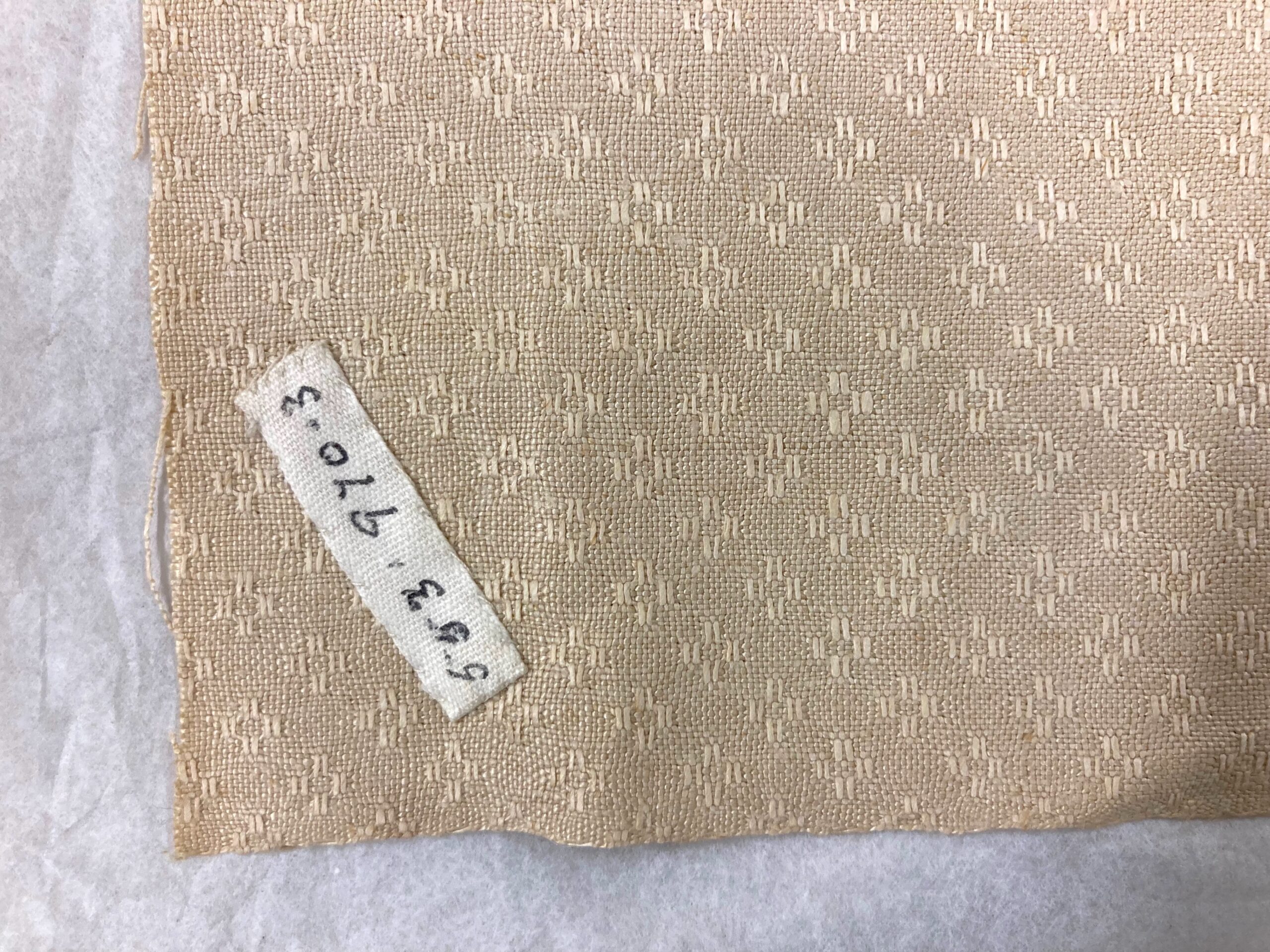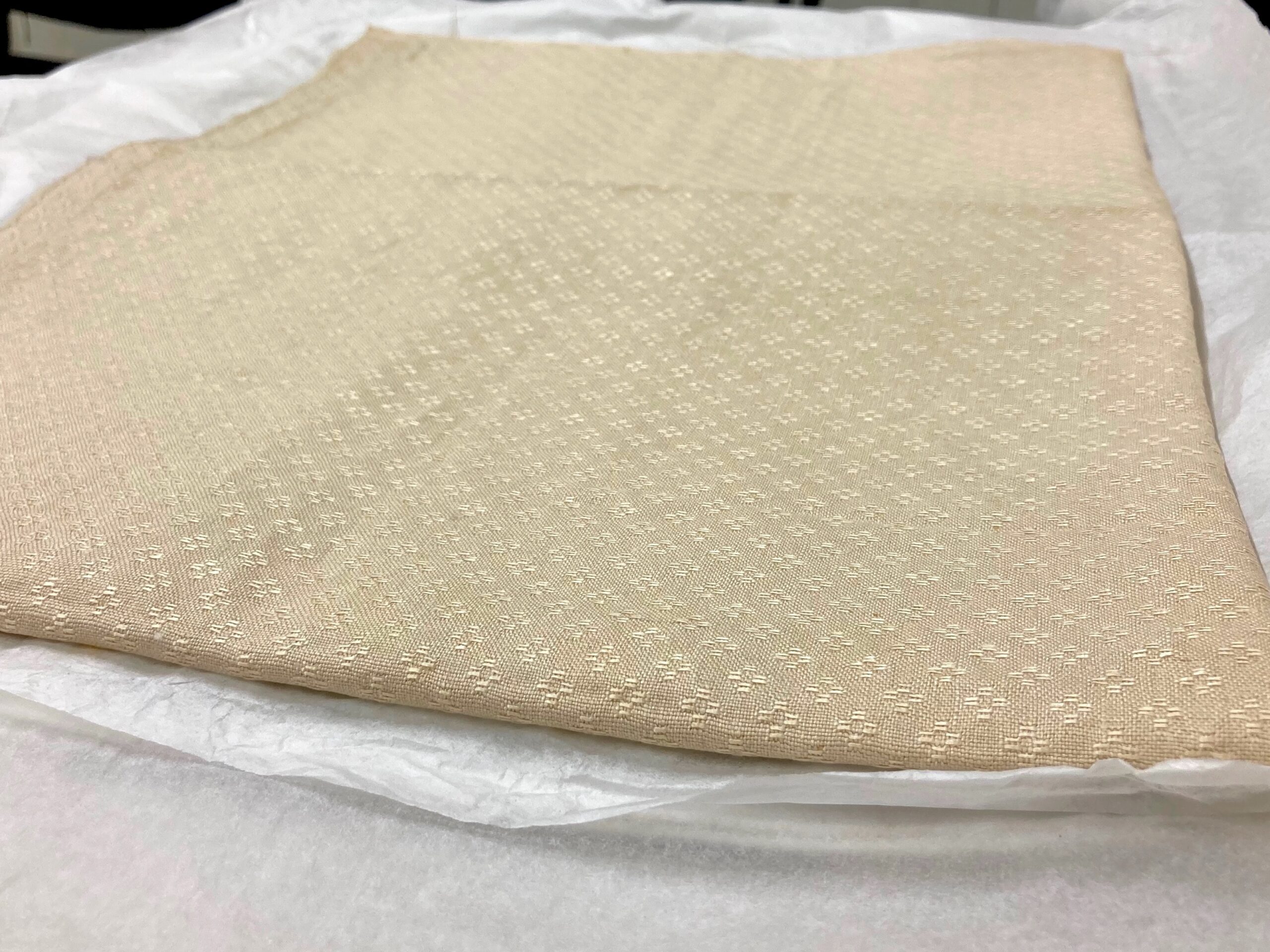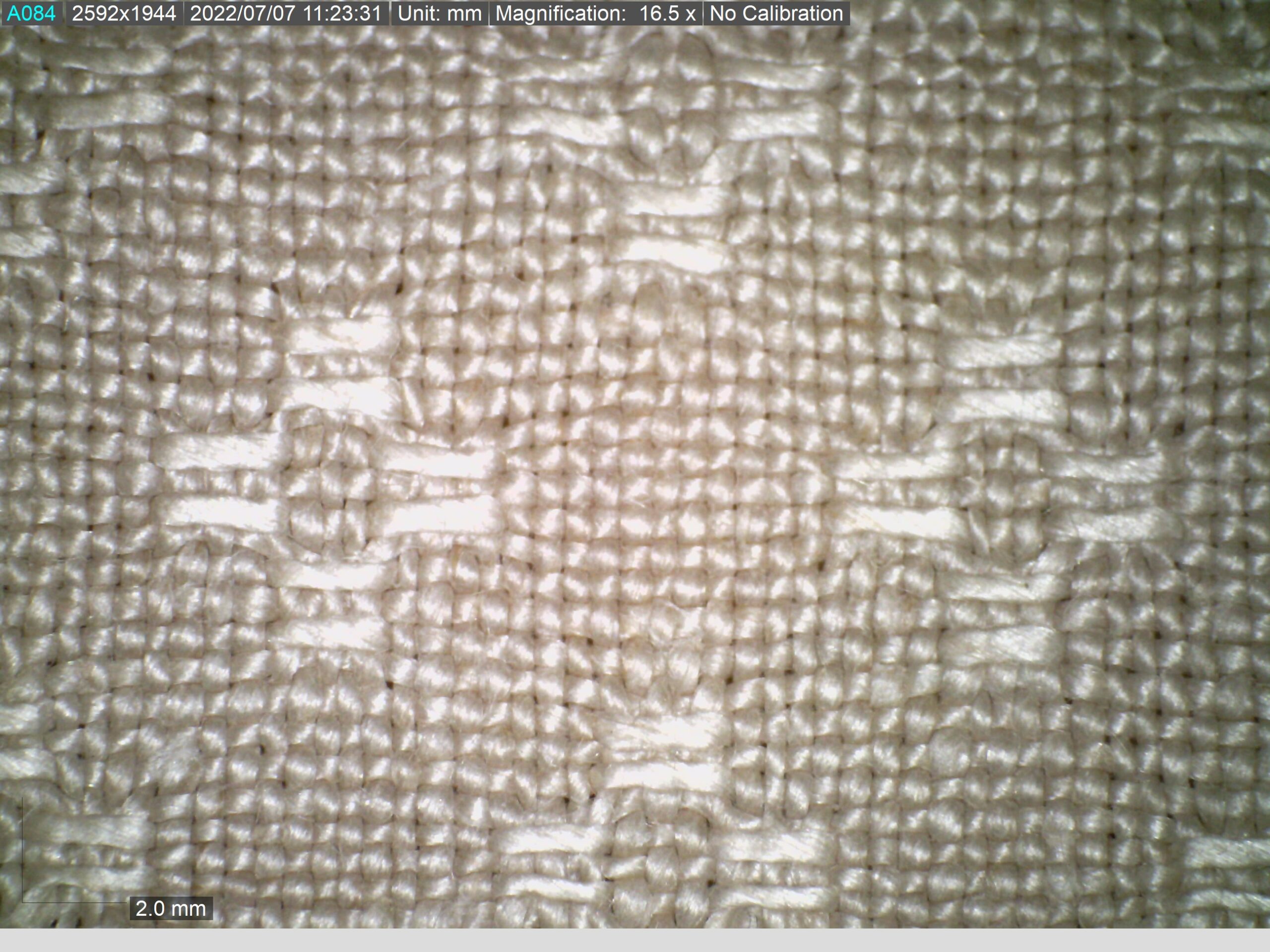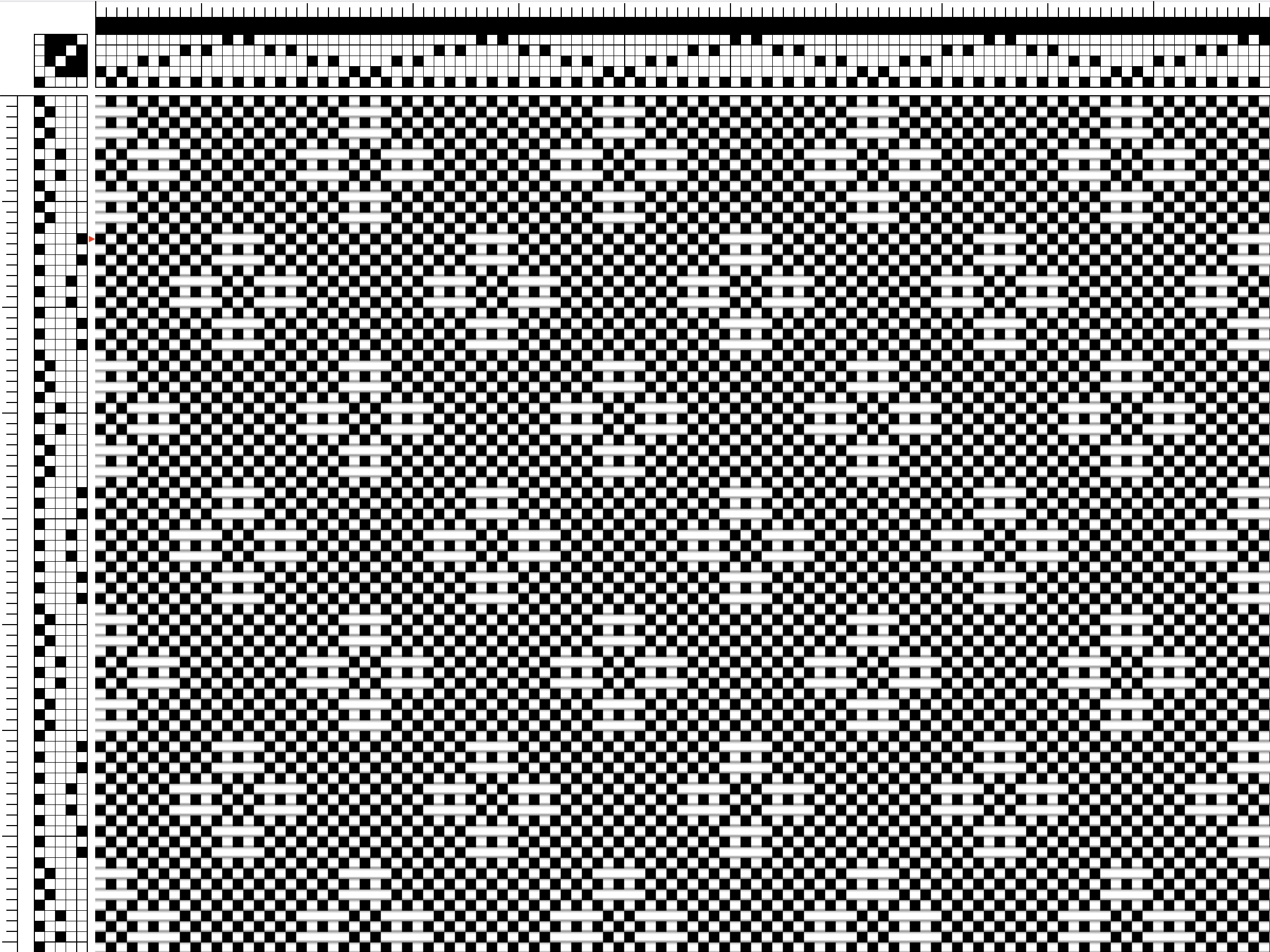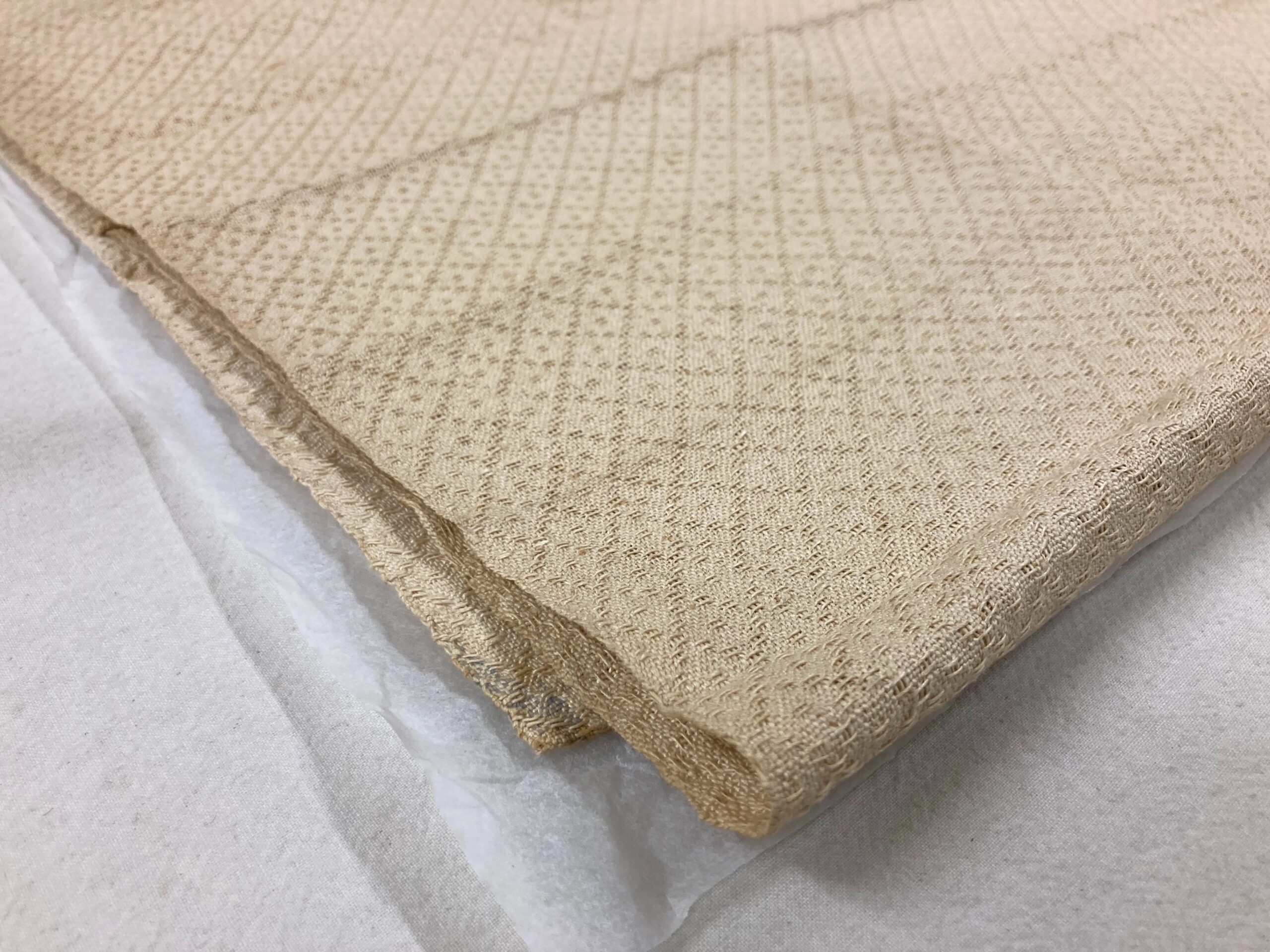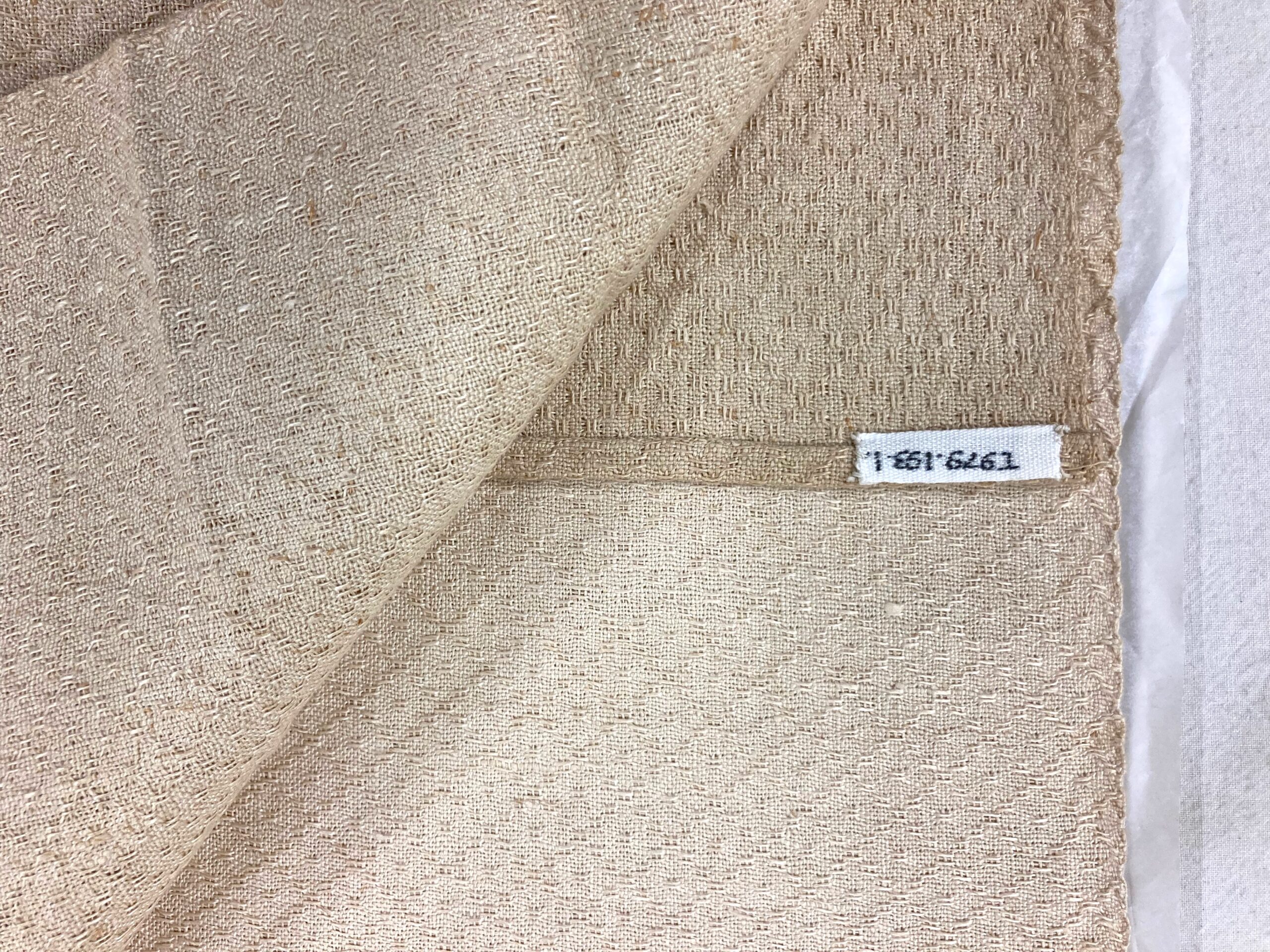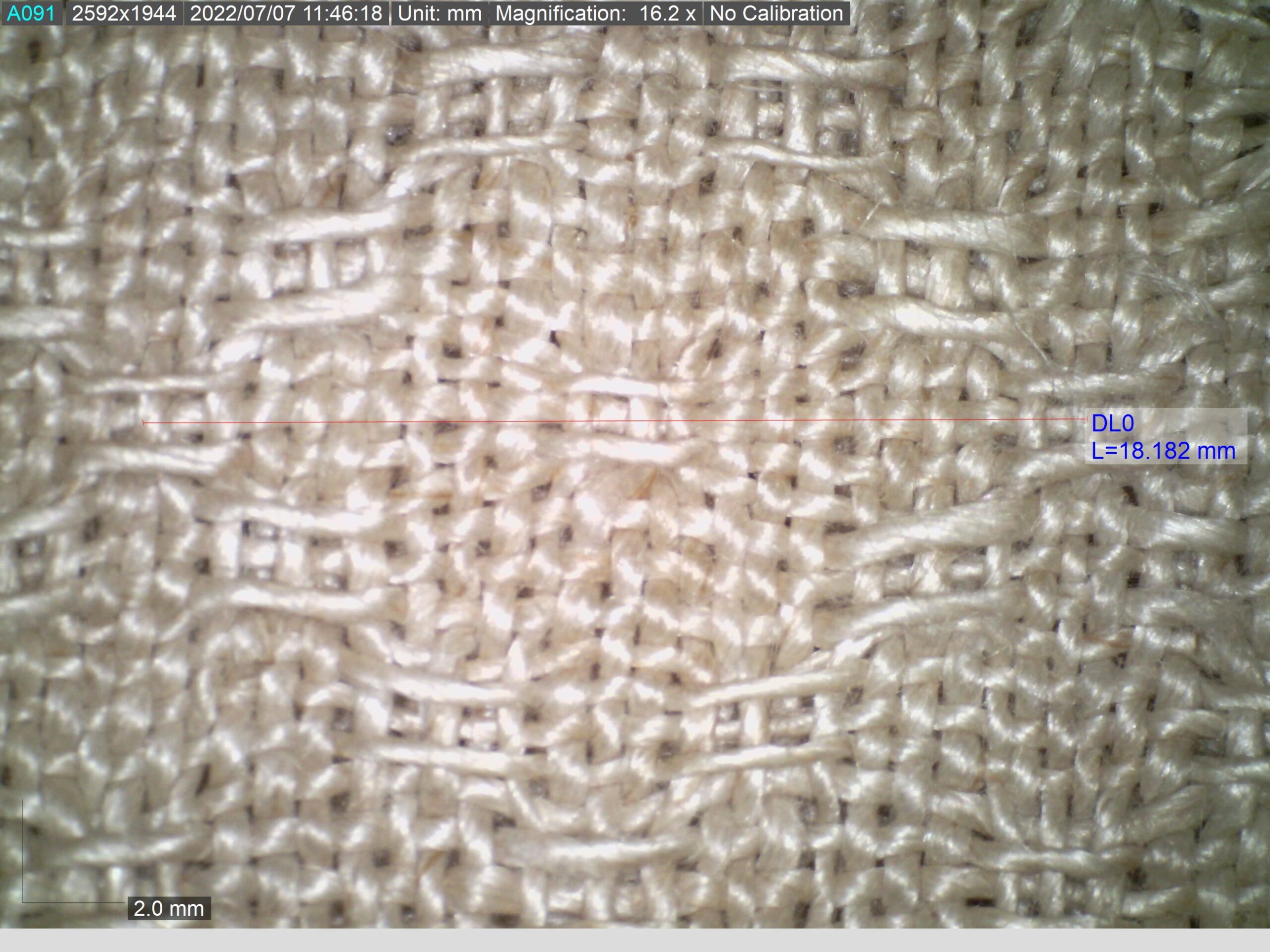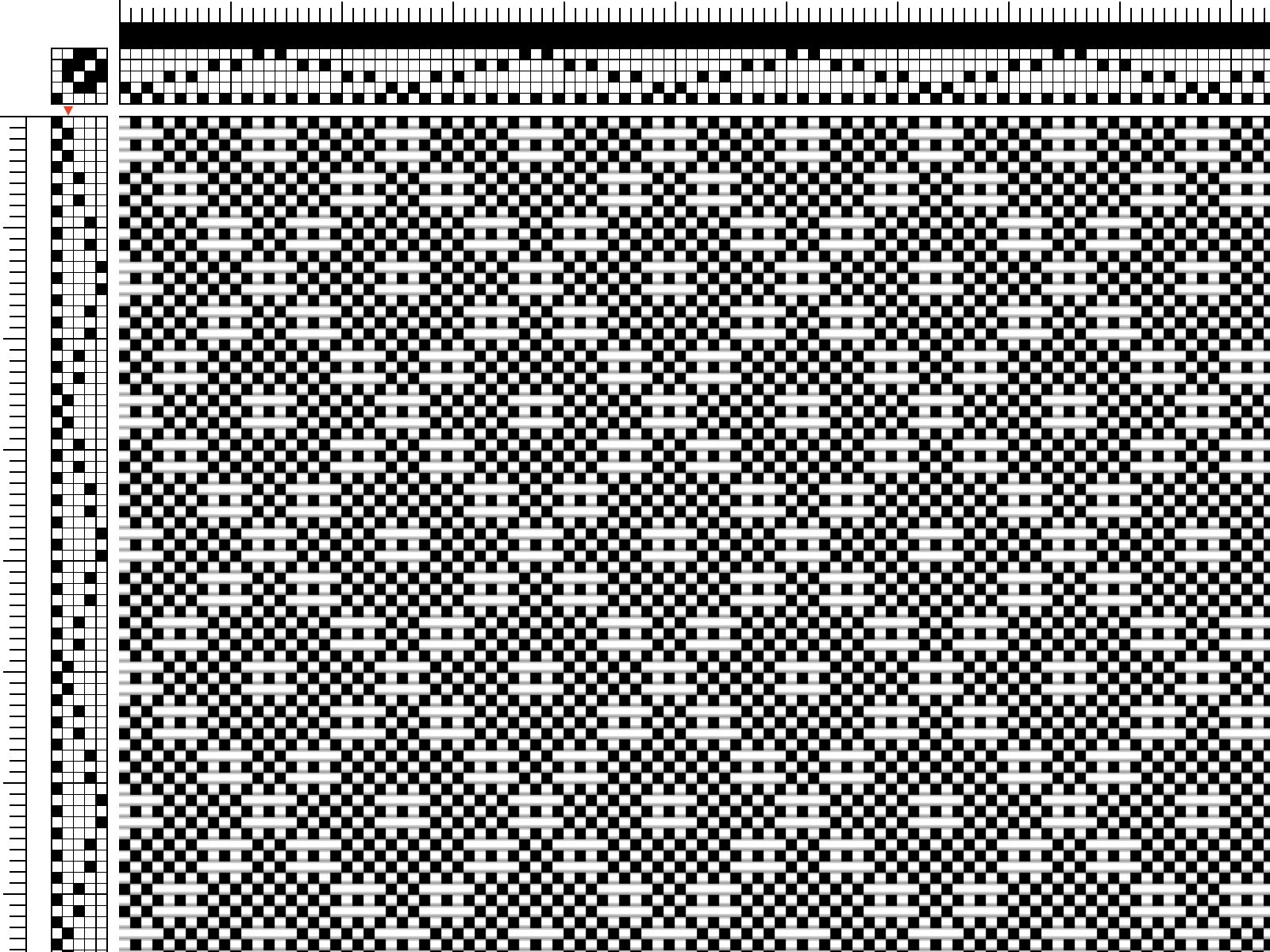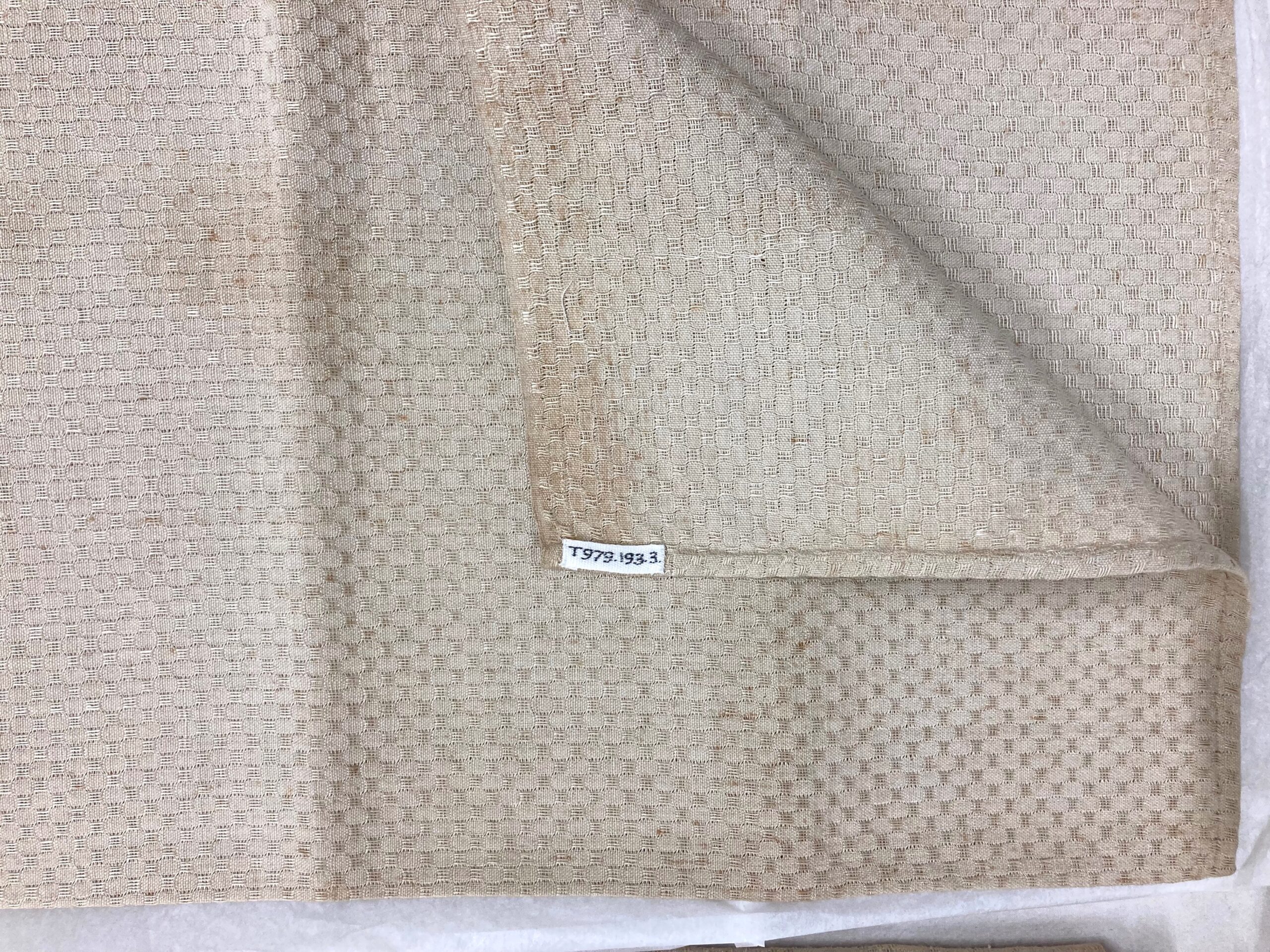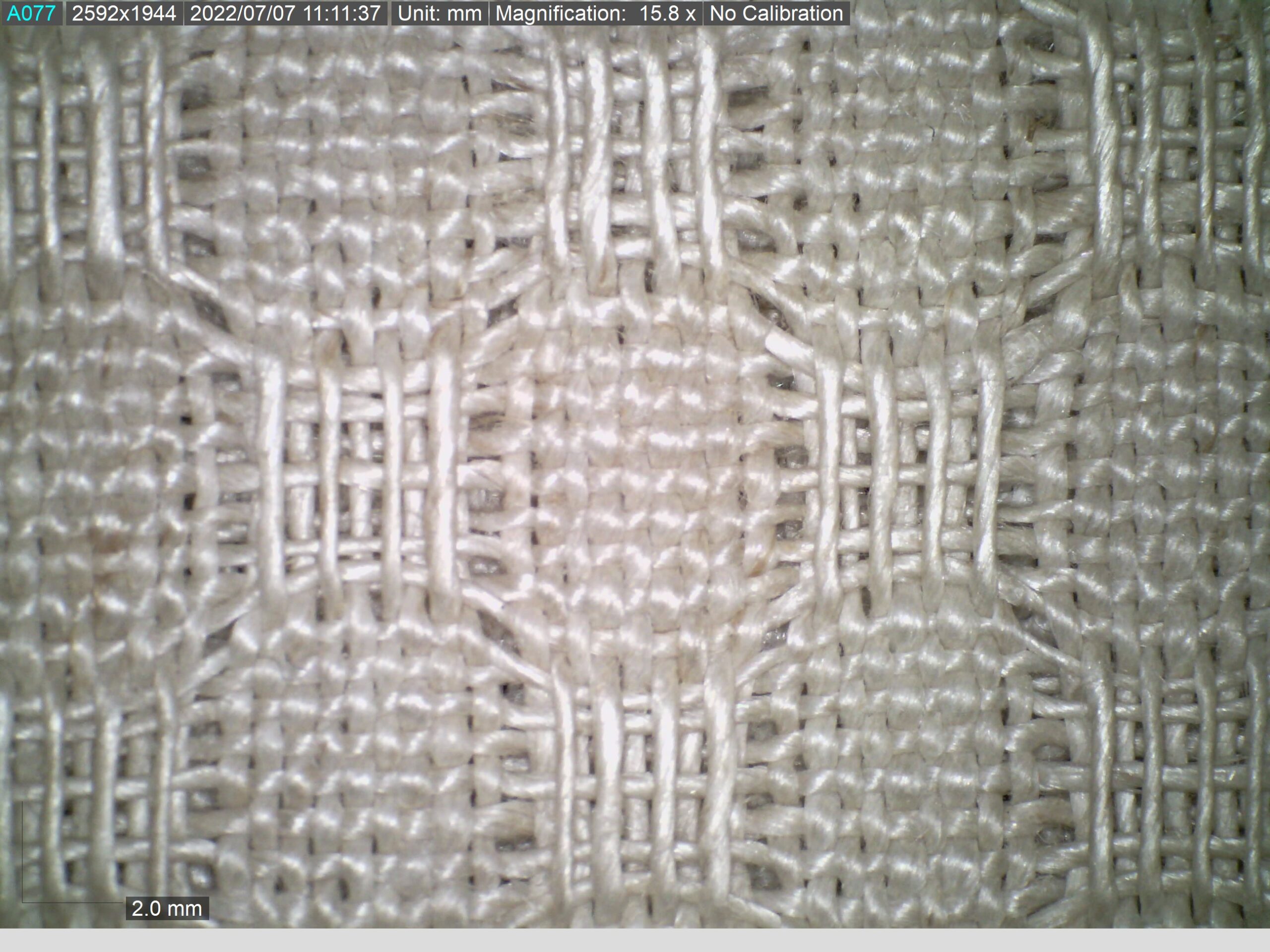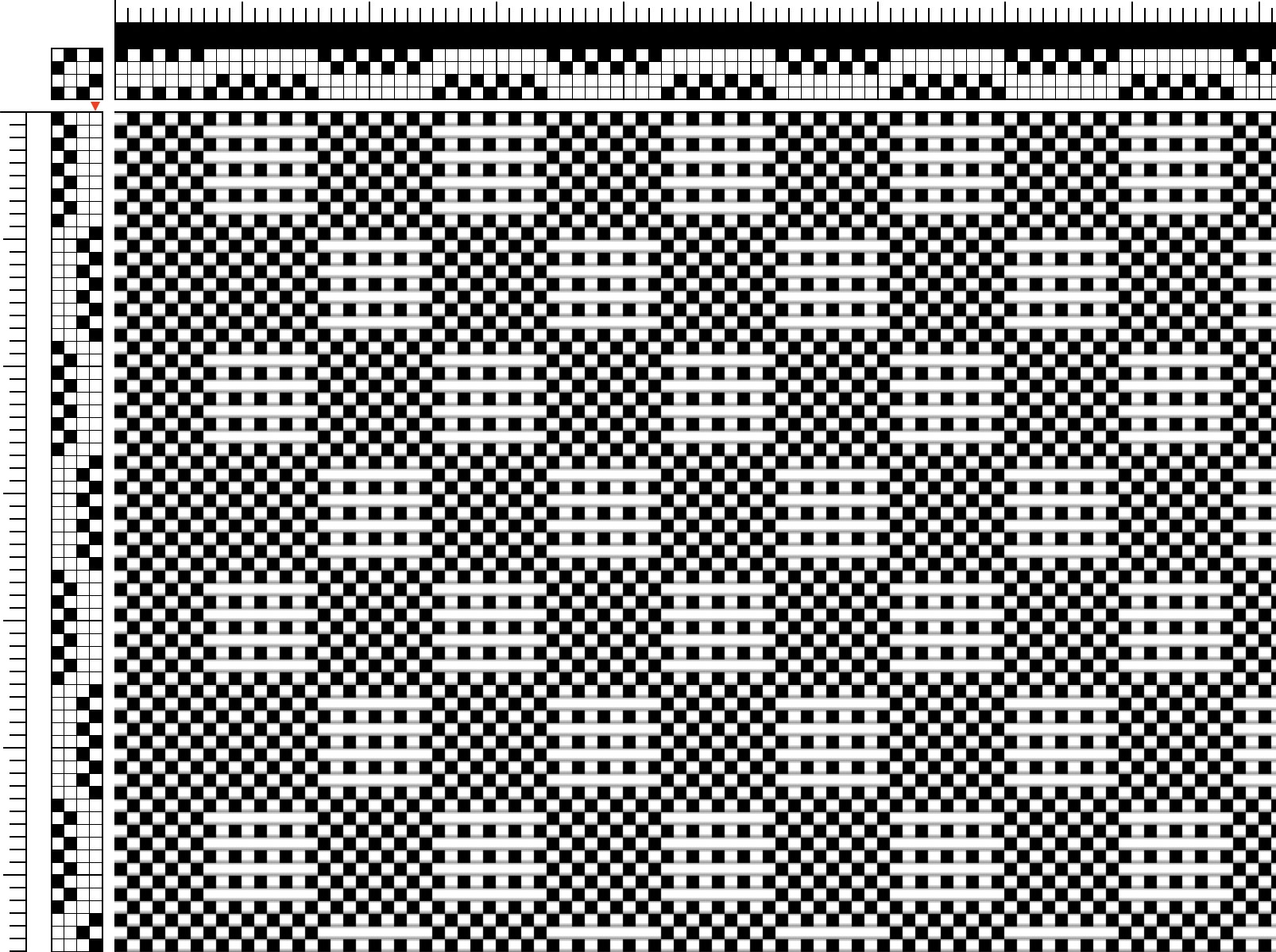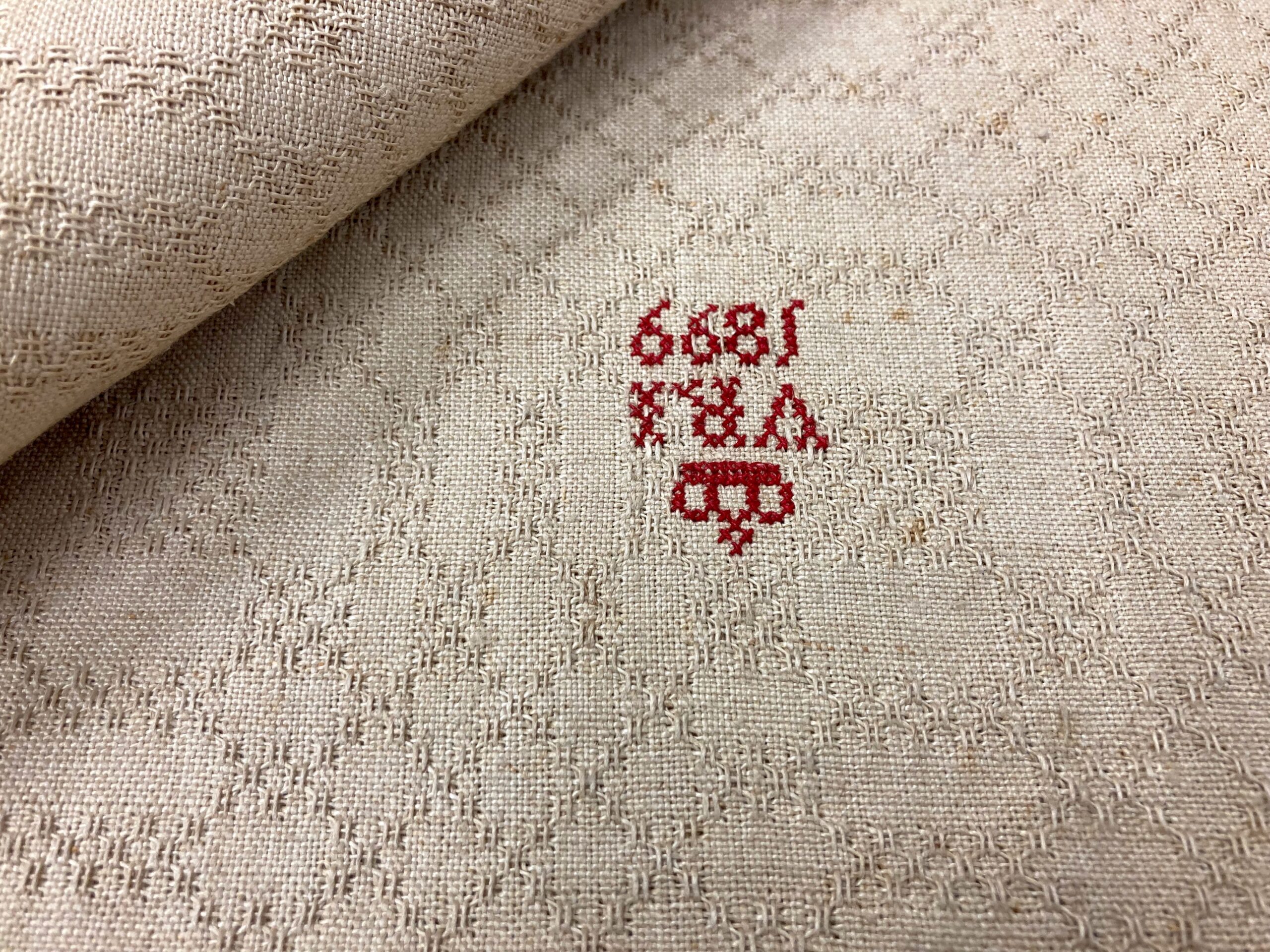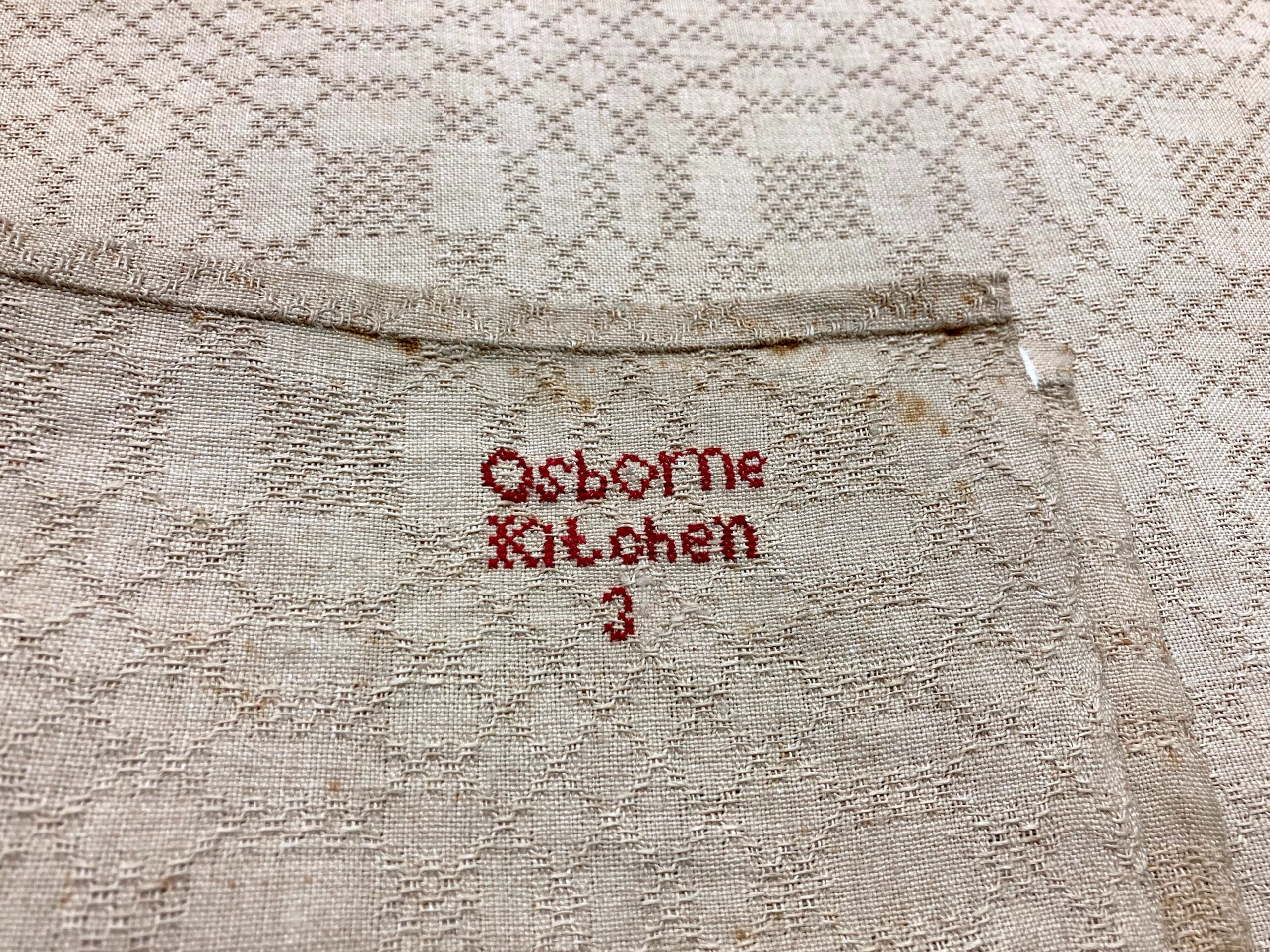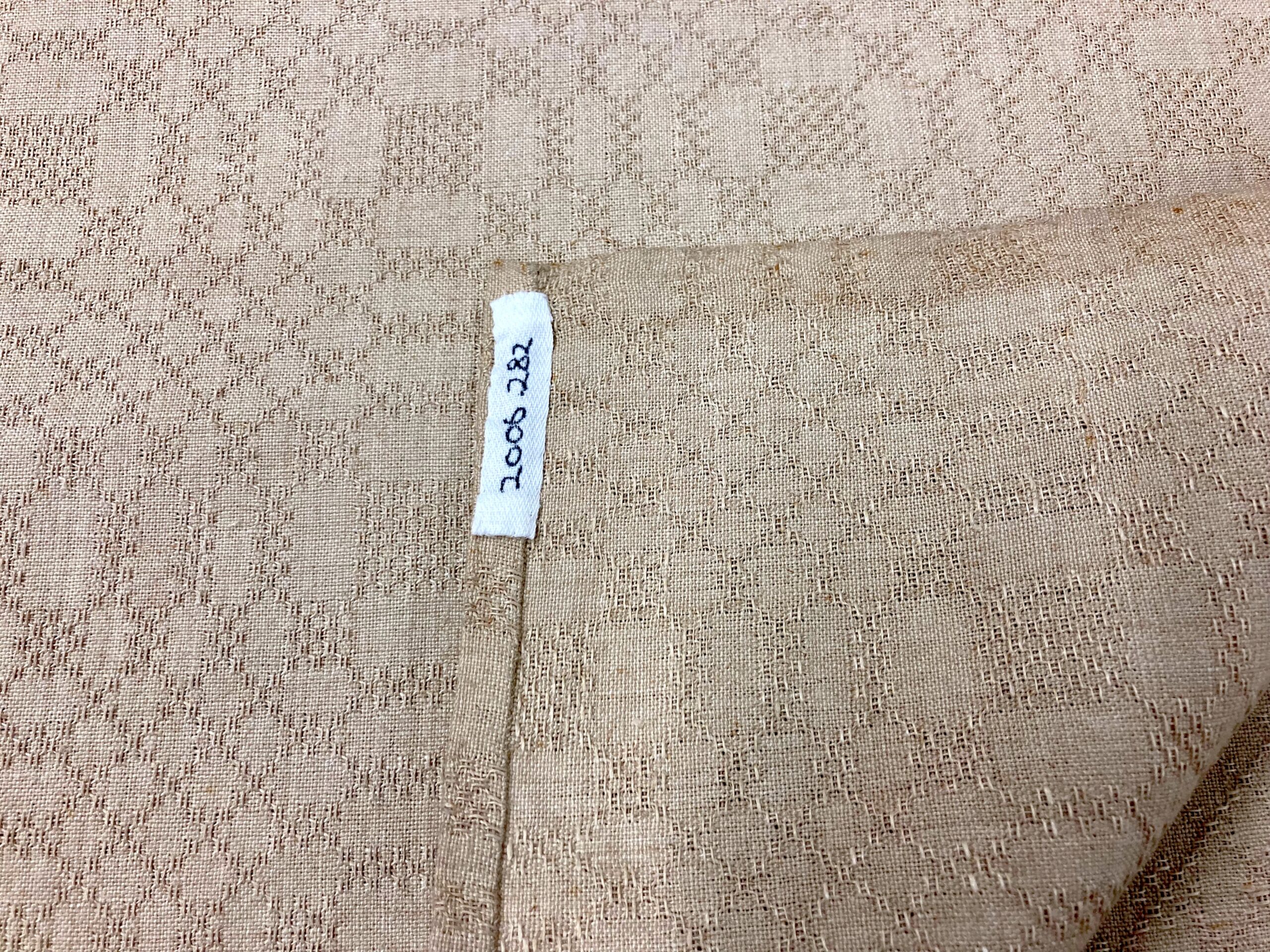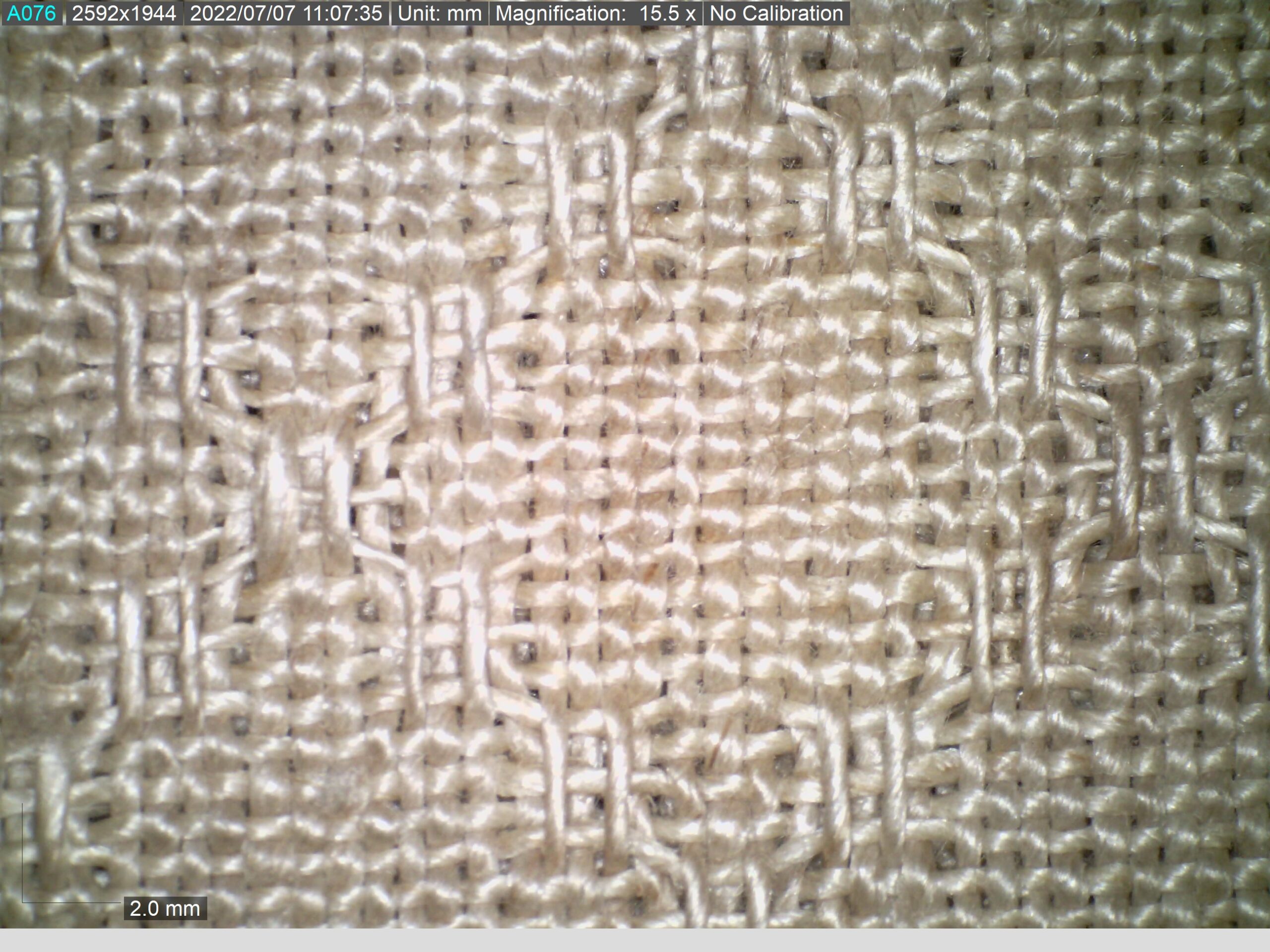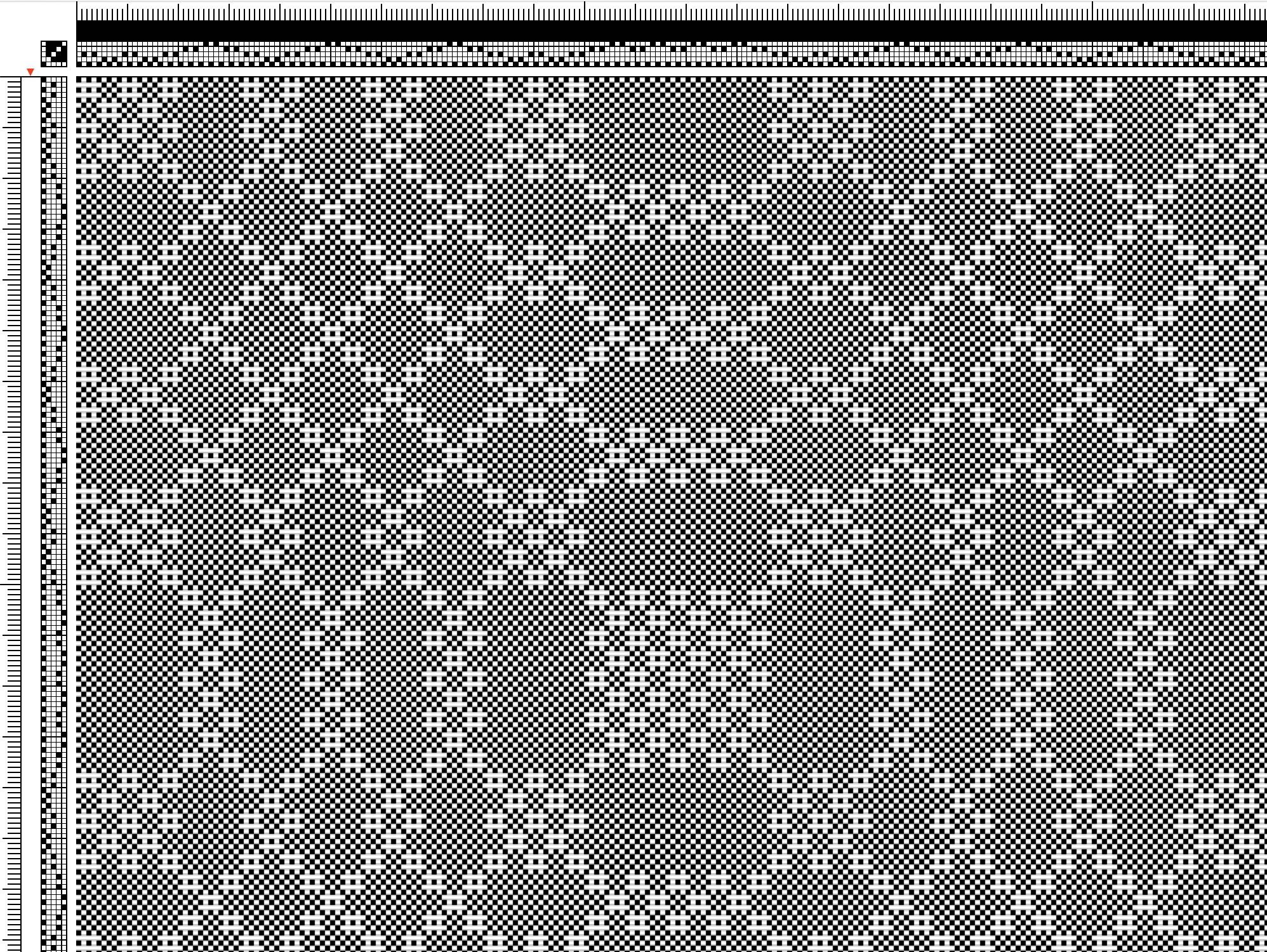(December 2022)
This is a post about my trip in July to view the collection of Lopham linen in Norfolk Museums, with photographs and descriptions of rare examples of handwoven huckaback cloth made around 1900.
I am grateful to Ruth Battersby Tooke, senior curator of Costume and Textiles at Norfolk Museums Service, and Rachel Kidd, curator at Gressenhall Farm & Workhouse, for welcoming me and unearthing items from storage.
Linen was manufactured on handlooms in the Norfolk villages of North and South Lopham for centuries. The firm of T. W. & J Buckenham of North Lopham survived into the 20th century by focusing on high quality linen for prestigious clients including the Royal Household, having received the Royal Warrant as suppliers of Diaper and Huckaback Table Cloths to Her Majesty in 1837. Perhaps most famous for their damask tablecloths woven on Jacquard looms, they also made fine sheeting on very wide looms, and huckaback towels. Some of this ‘Lopham linen’ was acquired by Norfolk Museums when Buckenhams finally closed in 1925. (1)
I had first read about Lopham linen in Nesta Evans’ The East Anglian Linen Industry (Rural Industry and Local Economy 1500-1850), whilst trying to establish a context for the manuscripts written by the 18th century Yorkshire weavers Ralph Watson and Thomas Jackson. A history of linen manufacture in Yorkshire has yet to be written, but Evan’s book on East Anglia sheds much light on an industry that once flourished across Britain. Norfolk Museum’s collection of Lopham linen provides an opportunity to study examples of traditional cloth made using methods that had changed little for hundreds of years. The Jackson and Watson manuscripts both include drafts for patterned huckabacks, and I knew that the Norfolk collection included some similarly elaborate huckaback towels made for Osborne House, Queen Victoria’s residence on the Isle of Wight.
The Museum of Norfolk Life occupies the eighteenth century Workhouse buildings at Gressenhall, near Dereham. Among the collection is a photograph of the weaver Albert Tyler (above), sitting behind one of the North Lopham looms, taken around 1900. Gressenhall also has a small painting from the early 1800’s, depicting one of the carts used by linen manufacturer William Buckenham to transport and advertise his wares. The firm of T.W. & J. Buckenhams was formed around 1800 when William, of South Lopham, joined forces with his brother Thomas of North Lopham. Also in the collection at Gressenhall is a fine Jacquard-woven damask tablecloth, with a central chequerboard pattern and the famous Lopham ‘spider-web’ motif in the corners.
–
Most of the Norfolk collection of Lopham linen is stored at Norfolk Museums Service in Norwich. My study visit was focused on the huckaback towels, which l describe below in order of their museum catalogue numbers. (2)
1970.553.1 (above) is a piece of pale huckback towelling, apparently from 1906. All of the huckabacks are labelled as unbleached and vary considerably in colour, this being the lightest. The term ‘linen’ once referred to cloth made from either flax or hemp, the latter being easier to grow and much used for domestic production, particularly for coarser cloth, until the middle of the 19th century. I assume the yarn for these Lopham linens is all flax, although I can’t be certain. Unbleached flaxen yarn varies somewhat in colour, and it was once common practice to bleach cloth, rather than yarn, through a lengthy process of exposure to sunlight and water. Partly bleached or not, this cloth appears to have been washed and ironed.
The weave structure is a standard 5-end huckaback, with one repeat every 10 ends and picks (see my weavers draft amongst the images above). One side of the cloth has weft-wise floats, each passing over 5 warp-ends, while the other side has warp-wise floats, each passing over 5 weft threads (picks). My analysis based on the close-up photographs taken by Ruth Battersby-Took estimates that the sett is about 45 ends per inch and about 33 picks per inch.
A note on the box in which 1970.553.1 was stored states the following: “Huckaback; Lopham Linen; fairly coarse, unbleached; rococo st design with label; Wood reff bleach – 1906; one of three patterns cut from long lengths now owned by Ipswich Museum”. However, a note on the museum database states: “Bleached Huckaback, Lopham linen. Early 20th C.”
–
1970.553.1 is another standard huckback, about 70cm wide, also very pale, and rather finer than 1970.553.1. I estimate the sett to be about 85 ends per inch and 65 picks per inch. The notes on the storage box and the database read: “Lopham linen; bleached fine birds eye; hand towel type; one of three patterns cut from long lengths now owned by Ipswich Museum”; and “Unbleached huckaback, diapered with label ‘Woodroff Bleach, 1906″.
–
1970.553.3 is a patterned huckaback. Whereas standard huckback is based on a 5-end unit, these patterned huckabacks are made up of 4-end units with pairs of floats in a tabby ground. These weaves are sometimes called barley corn, spot weaves or Bronson spots.(3) Here the pairs of floats are arranged in a staggered cross formation. This can be woven on 5 shafts. The cloth is about 70cm wide and the sett is about 48 ends and picks per inch. It has a creamy gold colour, definitely unbleached.
The notes on the box and database read: “Lopham linen; cream coloured, fairly fine, with diaper pattern; one of three patterns cut from long lengths now owned by Ipswich Museum”; and “Cream coloured, diamond patterned diapered, Lopham linen.”
–
1979.193.1 is similar to 1970.553.3, but the pairs of floats form a diagonal trellis arrangement. The colour is also similar, but it is somewhat coarser, sett at about 33 ends and picks per inch. There are no detailed notes on the box.
–
1979.193.3 is an unusual 9-end huckaback, each repeat being 18 ends and picks, with floats over 9 ends or picks. The sett is about 42 ends per inch.
–
2006.282 is perhaps the highlight of the collection. It has a pale golden colour and is about 94cm wide. It has been partly finished, keeping the woven selvedges, but hemmed at the end and embroidered in red with “Osborne Kitchens 3” on the back and “VRI 1899” and a crown motif, on the front. This elaborate huckaback uses the same structure as 1970.553.3 and 1979.193.1 but creates a larger pattern in the threading and treadling. It can also be woven on a loom with 5 shafts. The sett is about 36 ends and picks per inch.
The notes on the box reads: “Kitchen Towel made from Lopham linen for kitchens of Osborne House, Isle of Wight home of Victoria and Albert and family”.
Notes
1. For more information about the linen industry in the Lophams, see Michael Friend Serpell (1980): A History of the Lophams; and Eric Pursehouse (1966) Waveney Valley Studies.
2. The museum’s numbering system seems to have changed at some point; e.g. 553.970.1 is now 1970.553.1
3. For a fuller discussion of the this weave structure see Patricia Baines (1989): Linen: Hand Spinning & Weaving.
